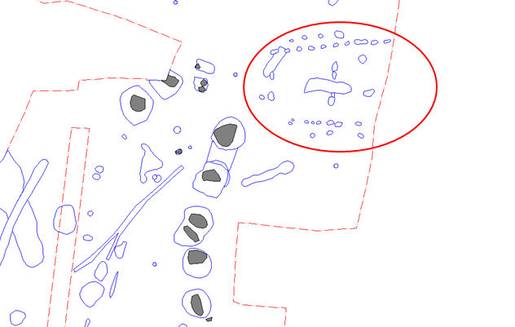- Steering group and management
- Sub-projects
- Jelling in GIS (Geographic Information System)
- Geophysical survey at Jelling
- Fieldwork 2011
- Archaeological fieldwork 2010
- Archaeological fieldwork 2009
- Jelling’s large stones
- The landscape around Jelling
- Place names in Jelling and its vicinity
- The bridge over Ravning Enge
- The travertine churches of East Jutland.
- Rune stones in context 2011
- Power and coins 2009
- Exhibitions
- Digitizing the photographs
North-east quadrant 2010
In 2006 and 2007 Vejle Museum revealed the first traces of an enormous palisade structure in Jelling, north and north-east of the mounds and the church. The northern side of the palisade was cut by a building, which typologically belongs to the end of the 900s or beginning of the 1000s. The palisade must therefore have been constructed and removed again in this period. The Jelling Project’s investigations in 2009 did not indicate extensive activity north of the structure. However, traces of other house sites were found inside the palisade during the earlier excavations. The function of these is not yet established and there may be further buildings located along the palisade’s eastern side. In 2010 the focus turns therefore to the north-eastern part of the palisade structure. The excavation will concentrate on three main themes:
Houses along the eastern side of the palisade
Archaeological investigations at other Viking Age settlements show that buildings often stood immediately inside the enclosures of the large residences, either at a right angle to the fence as at Tissø on Zealand, or alongside the fence, like at Lisbjerg north of Aarhus. The excavation will show whether this was also the case in Jelling. If there are no traces of buildings it could indicate that the construction in Jelling had a more specialised function than the other large residences.
The palisade
The Jelling structure is the largest known enclosure in terms of area from the Viking period. The internal area is c.12.5 ha, compared to the average size of 2-2.5 ha. The course of the palisade is extremely well-preserved in the north-eastern quadrant and the excavation is expected, together with the other investigations of the course of the palisade in 2010, to give information about the structure’s construction. It is hoped that this will include the use of material, which is assumed to have been substantial. The excavation also aims to identify the extent and date of a later fence line, which crosses the palisade structure’s northern side, together with the relationship between that later fence and the building that cuts the earlier palisade structure.
Sites of buildings inside the palisade
The buildings inside the monument complex fit into the house types of the Viking Age or the early medieval period. They provide an opportunity for establishing the complex’s period of use and also to clarify its internal organisation. The excavation therefore also aims to investigate the plans of the house sites in order to place the buildings into a relative chronological sequence - where they belong in terms of date and how extensive the settlement was at a specific point in time. More detailed knowledge of the structures inside the palisade will give an overview of the inner organisation of the Jelling complex and at the same time allow comparison of the settlement with other contemporary structures in Denmark and Scandinavia in general.
The excavation begins in June 2010 with a systematic excavation of the area in order to produce an overview of the structures inside and immediately outside the palisade. After this individual contexts and phenomena will be registered and investigated in detail. The sequence of the palisade’s corners will receive special attention aimed at clarifying the construction techniques. Entrances or other architectural elements, and the cutting of earlier or later features, will also be prioritised to learn about the nature of the structure and its development. Samples will be taken for dating purposes and, if possible, identification of the material. The investigations in 2006 and 2007 did not indicate serious disturbance from either earlier or later periods, which should provide a good basis for dating, by the C14 method, for example.
Project coordinators: Associate Professor Mads Kähler Holst and PhD student Mads Dengsø Jessen, Aarhus University.


